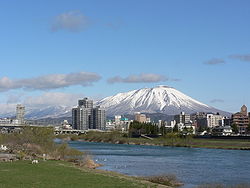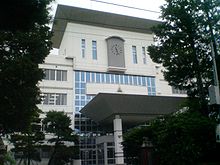- Morioka, Iwate
-
Morioka
盛岡— Core city — 盛岡市 · Morioka City City and Mt. Iwate 
FlagLocation of Morioka in Iwate prefecture Coordinates: 39°41′N 141°9′E / 39.683°N 141.15°ECoordinates: 39°41′N 141°9′E / 39.683°N 141.15°E Country Japan Region Tōhoku Prefecture Iwate prefecture Government - Mayor Hiroaki Tanifuji Area - Total 886.47 km2 (342.3 sq mi) Population (2005) - Total 300,740 - Density 588/km2 (1,522.9/sq mi) Time zone Japan Standard Time (UTC+9) City symbols - Tree Katsura - Flower Rabbitear iris Phone number 019-651-4111 Address 12-2 Uchimaru, Morioka-shi
020-8530Website www.city.morioka.iwate.jp Morioka (盛岡市 Morioka-shi) is the capital city of Iwate Prefecture, Japan.
As of 2005, the city has an estimated population of 300,740 and a population density of 588.11 persons per km². The total area is 489.15 km².
Morioka was founded in 1597 by Nobunao, the 26th lord of the Nanbu clan, as a castle town. In 1655 Nanbu-han was divided into Morioka-han and Hachinohe-han. Its name was changed from 森岡 to 盛岡 (both read as Morioka) in 1683 when the population was 36,000. The city was designated the capital of Iwate on April 1, 1889.
Contents
History
Morioka is in the territory inhabited by the Emishi people in ancient times. The general Sakanoue no Tamuramaro, who was ordered to conquer the Emishi, built Shiwa Castle here in 803, and the region gradually was brought under imperial control.
At the end of the Heian period, Morioka was under the control of the Ōshū Fujiwara Clan based in Hiraizumi, to the south of Morioka. The clan was destroyed by shogun Minamoto no Yoritomo, and the Kudo Clan replaced it. During the Muromachi period, the Nanbu clan, based in Sannohe to the north, expanded its territory and built Kozukata Castle here. Kozukata changed its name to Morioka in the 17th century.
In the Boshin War, Morioka made a pro-shogunate alliance with Aizu, and fought against the imperial force. As a consequence Kozukata castle was destroyed in 1874.
As a consequence of the 2011 Tōhoku earthquake, Morioka was hit by a 6.1 earthquake.[1]
Merger
On January 10, 2006, the village of Tamayama, from Iwate District, was merged into Morioka.
Geography and climate
Morioka is located in the Kitakami Basin at the confluence of three rivers, the Kitakami, the Shizukuishi and the Nakatsu. The Kitakami River is the second largest river on the Pacific side of Japan (after the Kiso Gawa) and the longest in Tohoku. It runs through the city from north to south. An active volcano, Mount Iwate, dominates the view to the northwest of the city. Mount Himekami is to the north and Mount Hayachine can sometimes be seen to the southeast.
Climate data for Morioka, Iwate Month Jan Feb Mar Apr May Jun Jul Aug Sep Oct Nov Dec Year Average high °C (°F) 1.5
(34.7)2.4
(36.3)6.4
(43.5)14.0
(57.2)19.8
(67.6)23.2
(73.8)26.5
(79.7)28.1
(82.6)23.4
(74.1)17.5
(63.5)10.7
(51.3)4.3
(39.7)14.8 Average low °C (°F) −6.6
(20.1)−6.1
(21.0)−2.8
(27.0)2.5
(36.5)7.9
(46.2)13.3
(55.9)18.0
(64.4)19.2
(66.6)14.0
(57.2)6.7
(44.1)1.1
(34.0)−3.3
(26.1)5.3 Precipitation mm (inches) 57.5
(2.264)53.0
(2.087)79.8
(3.142)92.7
(3.65)94.1
(3.705)110.1
(4.335)170.7
(6.72)168.6
(6.638)161.8
(6.37)101.0
(3.976)90.3
(3.555)72.9
(2.87)1,252.5
(49.311)Snowfall cm (inches) 71.7
(28.23)51.3
(20.2)37.6
(14.8)3.1
(1.22)0
(0)0
(0)0
(0)0
(0)0
(0)0
(0)6.7
(2.64)40.8
(16.06)211.2
(83.15)% humidity 73.4 71.2 68.8 66.2 68.9 76.2 81.4 80.9 81.1 78.3 75.1 74.4 74.66 Sunshine hours 136.3 144.9 183.7 195.8 215.4 185.7 169.1 185.5 149.8 165.7 134.1 119.0 1,985 Source: Japan Meteorological Agency Transportation
Morioka Station was the original northern terminal of Tohoku Shinkansen. The line was extended to Hachinohe in 2002, but the station has kept its significant role in the traffic of northern Tohoku. Akita Shinkansen also branches off at the station.
Culture
The Iwate Museum of Art in Morioka displays works by three notable local artists, Tetsugoro Yorozu, Shunsuke Matsumoto and Yasutake Funakoshi, as well as holding exhibitions on national and international themes.
Temples and shrines
Hoonji is a temple which was originally built at Sannohe by the 13th lord of the Nambu Clan, Moriyuki, in 1394, and brought to Morioka by the 27th lord, Toshinao. It was considered the head temple among the 280 operated by the Nambu Clan. its notable feature is the Rakando (Statues Hall), built in 1735 and rebuilt in 1858. It's central statue Rushana-butsu is reported to be made by Kodo-daishi. Within the Rakando 500 Rakans, ('holy people who deserve other's offerings') which were made in Kyoto and later brought to Morioka, rest on a series of 5 rows of shelves that stretch around the room. Included among their number are representations of Kublai Khan and Marco Polo. Today it is known as a Zen training temple for monks.
Mitsuishi temple (literally, 'three rocks'), has three large rocks on the grounds with shackles around them to represent the story of 'Oni no tegata', which is a legend explaining the origin of the name of Iwate prefecture. According to the legend, there was once a devil who often tormented and harassed the local people. When the people prayed to the spirits of Mitsuishi for protection, the devil was immediately shackled to the rocks and made to promise never to trouble the people again. As a sign of this promise, the devil left a handprint on one of the rocks, thus giving rise to the name Iwate, literally meaning ‘rock hand’. Even now after a rainfall it is said that the devil’s hand print can still be seen.
Food
Morioka attracts tourists with local noodles such as jajamen, reimen, and wanko soba. Brewing is also a thriving industry of the city. Nambu Senbei, a type of rice cracker, is considered a local delicacy. Gyutan (beef tongue) is also somewhat popular.
Education
Morioka operates its public elementary and junior high schools.
Iwate Prefecture operates public high schools, including:
Twinnings
 Victoria, British Columbia, Canada (since 1985)
Victoria, British Columbia, Canada (since 1985)
Notable persons
- Ishikawa Takuboku, poet
- Kenji Miyazawa, poet and author of children's literature
- Takashi Hara, former Prime Minister of Japan
- Inazo Nitobe, author, educator, diplomat, and politician during the Meiji period and Taishō period
- Seishirō Itagaki, general in the Imperial Japanese Army
- Katsura Funakoshi, sculptor
- Mitsumasa Yonai, former Prime Minister of Japan
- The Great Sasuke, professional wrestler
- Taka Michinoku, professional wrestler
- Takatō Ōshima, engineer - made the first Western-style cannon in Japan
References
- ^ http://www.marketwatch.com/story/new-61-magnitude-quake-hits-near-morioka-japan-2011-03-11 - retrieved March 14, 2011
External links
- Morioka official website (Japanese)(English) (German)
- Japan Food Guru (Listing of events, sites, and restaurants in Morioka)
 Iwate Prefecture
Iwate PrefectureCities Hachimantai | Hanamaki | Ichinoseki | Kamaishi | Kitakami | Kuji | Miyako | Morioka (capital) | Ninohe | Ōfunato | Ōshū | Rikuzentakata | Tōno
Districts See also: Towns and villages by district Metropolitan cities of Japan Tokyo Metropolis Designated cities Core cities Akita · Amagasaki · Aomori · Asahikawa · Fukuyama · Funabashi · Gifu · Hakodate · Higashiōsaka · Himeji · Iwaki · Kagoshima · Kanazawa · Kashiwa · Kawagoe · Kōchi · Kōriyama · Kumamoto · Kurashiki · Kurume · Maebashi · Matsuyama · Miyazaki · Morioka · Nagano · Nagasaki · Nara · Nishinomiya · Ōita · Okazaki · Ōtsu · Shimonoseki · Takamatsu · Takasaki · Takatsuki · Toyama · Toyohashi · Toyota · Utsunomiya · Wakayama · YokosukaSpecial cities Akashi · Atsugi · Chigasaki · Fuji · Fukui · Hachinohe · Hirakata · Hiratsuka · Ibaraki · Ichinomiya · Isesaki · Jōetsu · Kakogawa · Kasugai · Kasukabe · Kawaguchi · Kishiwada · Kōfu · Koshigaya · Kumagaya · Kure · Matsumoto · Mito · Nagaoka · Neyagawa · Numazu · Odawara · Ōta · Sasebo · Sōka · Suita · Takarazuka · Tokorozawa · Tottori · Toyonaka · Tsukuba · Yamagata · Yamato · Yao · YokkaichiPrefectural capitals
(not included above)Categories:- Morioka, Iwate
- Cities in Iwate Prefecture
- Populated places established in 1597
Wikimedia Foundation. 2010.





